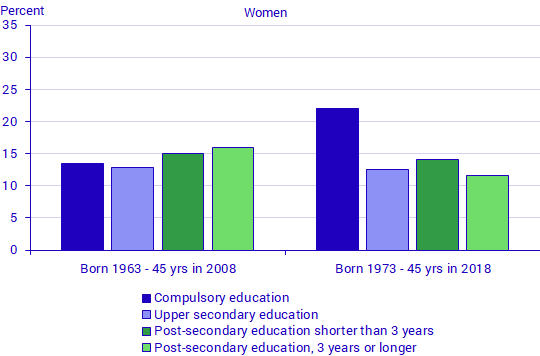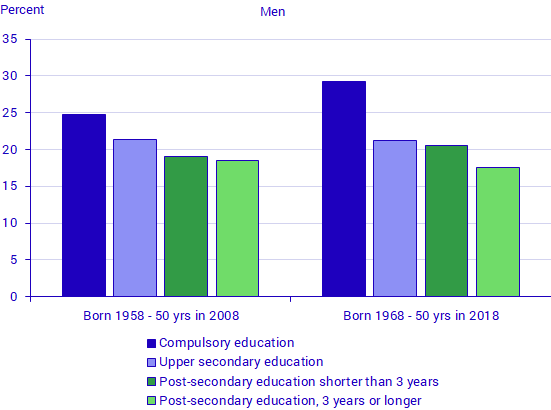Demographic analysis: Worlds apart? Demographic inequalities in Sweden
Lowest proportion of persons without children among those with long education
Statistical news from Statistics Sweden 2020-02-21 9.30
The proportion of women and men without children has varied over generations. A new report from Statistics Sweden shows how childlessness differs at different ages and between different groups, for example based on level of education.
Statistics Sweden produces a projection of Sweden’s population every year. The projection is based on assumptions on factors such as the future development of childbirth. A central matter in assumptions on childbirth is the percentage of women who do not give birth to any children.
Among those who recently reached an age when most people no longer have children, 13.5 percent of the women and 21.5 percent of the men did not have children. However, there are differences between various groups, for example based on education level.
Proportion without children differs by education level
Among women who recently turned 45 years, born in 1973, those with a long post-secondary education had the lowest levels of childlessness (see figure below). Persons with compulsory education had the highest levels of childlessness. Persons born ten years earlier, in 1963, the proportion of childlessness was instead largest among those with a longer post-secondary education.
For men, the proportion of persons without children is measured at 50 years. There are no major differences between persons who recently turned 50 years, born in 1968, and those born ten years earlier, in 1958. For both years of birth, the lowest levels of childlessness were among persons with a longer post-secondary education.


Proportion with post-secondary education has increased
The proportion of persons with a post-secondary education has increased between the years of birth in the comparison, in particular for women. Among women born in 1963, just over 30 percent had either a long or a short post-secondary education, while among those born in 1973 the corresponding figure was 50 percent. Among men this increase has not been as prominent. Among men born in 1958, 27 years later, in 1968, the corresponding figure was 33 percent. On the other hand, the proportion of those with compulsory education has declined from 13 percent to six percent among women and from 22 percent to 9 percent among men.
The fact that more people study at university or at higher education institutions, together with other factors, has contributed to a higher average age for new parents among those who have children. Despite the fact that a higher proportion of people were without children at, for example, 35 years, by the end of their childbearing years, there was no difference in the proportion of persons without children.
Among persons born in the late 1970s, who have not reached the end of their childbearing years, the proportion of persons aged 35 years without children has continued to increase. However, there are differences between education levels here as well. Among persons with a longer post-secondary education, the proportion of persons aged 35 years without children has declined, among both women and men.
The report “Utan barn – Skillnader i barnlöshet mellan kvinnor och män i olika grupper” (“No children - differences in childlessness between women and men in various groups”) looks at childlessness based on other factors as well, such as whether their parents are Swedish born or foreign born, and on employment.
Definitions and explanations
These statistics only refer to Swedish born women and men. In this publication, childlessness is defined as not having given birth in Sweden. The education level is measured at 35 years.
This statistic is produced with information from Statistics Sweden’s Population Register, which only shows whether or not a person had children. To determine whether persons who did not have children were voluntarily or involuntarily childless would require asking them, which was not done.
Publication
Feel free to use the facts from this statistical news but remember to state Source: Statistics Sweden.
